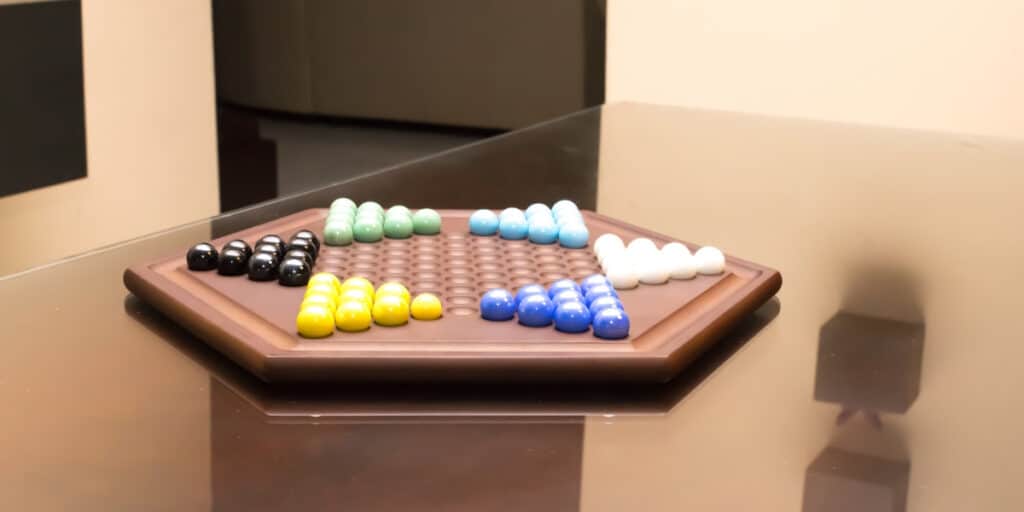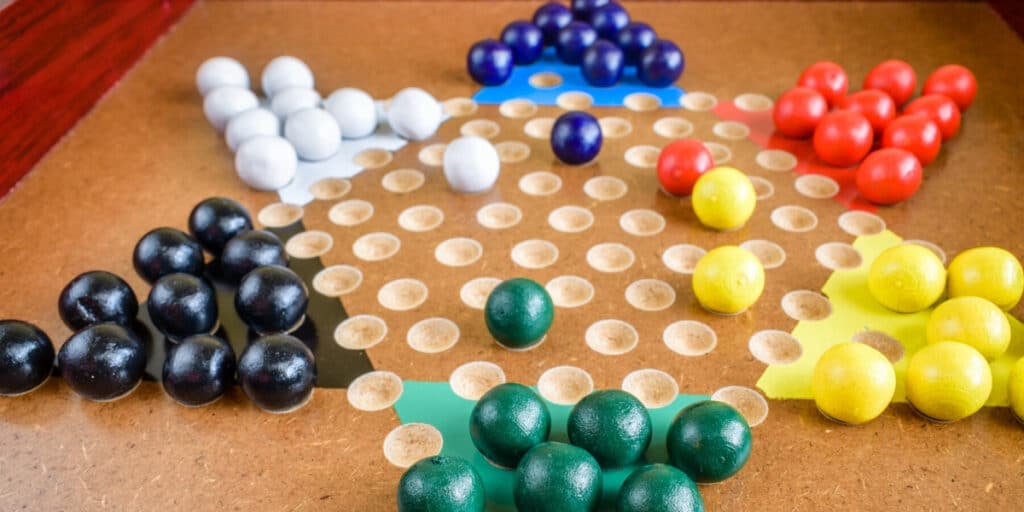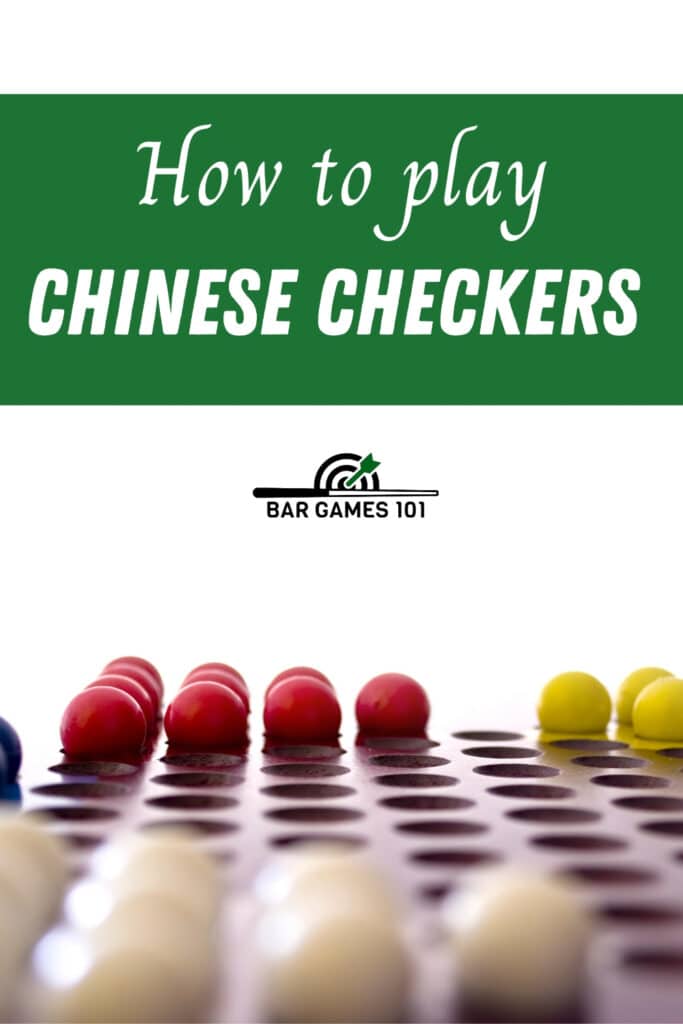So you’ve found that old Chinese Checkers board you had as a kid and want to play, but you can’t remember how to play.
Or, perhaps you’ve never played it before and want to learn this game with its intriguing looking game board. What are the rules to Chinese Checkers and how do you play?
Well, blow the dust off that old board and pull up a seat. Because we are going to be teaching you how to play.
(Trivia fact: Chinese Checkers does not originate from China. It was, in fact, invented in Germany in 1892)
The Easy Set-Up

Set up is as easy as saying “Chinese Checkers”.
The board is in the shape of a six-pointed star with each point assigned a different color.
Each of these points has ten pegs or marble holes to place your pieces and face one another from across a hexagonal field of additional marble holes.
The hexagon’s outer edges are made up of five marble holes from each of the star points.
Just place the board in front of you and fill in the colored triangles with their corresponding color for as many players as are playing – between two and six.
There are different ways of playing depending on how many players are in each game, but we’ll cover those details more below.
That’s it. You are done setting up and ready to play. Now, simply toss a coin to determine who makes the first move and it’s game on.
But wait … What is the objective?

Before you start moving your pieces around the board, you need to know where and why you’re moving them.
Your objective is to move all of your marbles from your colored triangle to the colored triangle opposite you.
The first person to move all of their marbles into their opponent’s triangle wins the game.
Now, let’s take a quick look at the rules and some instructions on how to play.
Do you love board games? Check out our list of the best strategy board games you should try!
Chinese Checkers Rules

The rules for Chinese Checkers are simple and straightforward. They are listed below but as with all games, they must begin with …
The All-Important First Move
There are two popular opening moves you can choose from, but you are certainly not limited to these. Try them to see how they work for you.
The first move is called the Sidewinder.
The Sidewinder involves moving your outermost marble or peg from your front line, diagonally outwards from your color triangle, away from your centerline.
The second move is the Cross Caterpillar.
With the Cross Caterpillar, you start again with your outermost marble on your front line but this time you move it diagonally inward, toward your centerline.
Each of these moves allows for a different strategy and both are very effective.
Taking a Turn
With each turn, a player can move one marble.
The marble can be moved adjacently, or it may be hopped.
You can hop over as many marbles as are available to hop, including your own, and you may change the direction of your piece with each jump if there is a place open for it.
When hopping, you may only jump over one marble at a time if there is a space between them.
In other words, you cannot hop over two marbles next to one another with one hop or jump; there must be a gap between them in which to land.
If there is a gap after the next marble, you may hop again.
(Trivia fact: Chinese Checkers is based on an American made game called Halma – similar to Chinese Checkers but with increased complexity as Halma is played on a board with eight sides rather than six.)
Do you like playing backgammon? You should read our top strategies on how to win in backgammon!
Blocking

Blocking can occur when one player obstructs another player from being able to move their piece.
This can be done by filling in peg holes around their pieces to block a player from hopping.
Blocking can also happen when one player has filled the other player’s star point with all their colored marbles but one.
The opposing player may have left a piece there to block the final marble from being placed.
One way around this would have been agreed on before the game began. You may choose to allow that the winning player simply swap the blocking piece for their own and thus win the game.
Playing with 2, 3, 4, 5 or 6 players.
There are several ways to play Chinese checkers:
- The 2 player Game
Both players move all of their marbles across the board to the other player’s start point.
You also have the option to play with multiple sets of marbles. Each player would play using 2 or 3 sets or colored marbles moving all of them across the board in order to win.
- The 3 player Game
With 3 players, each can use 1 or 2 sets of marbles.
If using just one set, the players simply move to the opposite empty star point, which is the same as a 2 player game.
If 2 sets are used, the players will set up their colors on opposite sides of the board and must then move their colors to their own opposite side.
- The 4 player Game
In a 4 player game, it is a standard game of Chinese checkers where two opposite sides are left open.
- The 5 player Game
This is an unusual one and not played often.
One player will have an advantage as they will have an empty space opposite and so less resistance.
This version tends to be played with the youngest player as player five, to help them learn the game and feel the accomplishment of sometimes winning.
- The 6 player Game
Similar to the 2 player game. The players each have a separate color and must move their marbles to the opposite corner.
The Win

When one player has been able to move all of their pieces from their colored triangle or start point, into their opponent’s colored triangle, they have won the game.
It is time to do the celebration dance.
If you are playing with a younger player who won, we suggest the losing players pick up the winner and put them on their shoulders and parade them around outside as the Ultimate Chinese Checker Champion.
(Trivia fact: Chinese Checkers was marketed in America in 1928 as “Hop Ching Checkers but the name was later changed to Chinese Checkers. It was all a marketing ploy to appeal to America for the popular interest in oriental themes.)
Some things to consider
Forfeits – You may choose to put a rule into place that states: if a player finds themself unable to move during a turn, they forfeit the game.
Though you may consider a less harsh ruling that they simply miss a turn and continue on as normal once the other player or players play through.
Are there strategies to increase your chances of winning? Yes, of course there are!
We’ve written up some strategies specifically to help you win. Just click here to find out more about them. 10 Chinese Checkers Strategies to Always Win
Have a look at our Chinese Checkers playing board recommendations.



